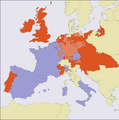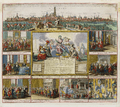War of the Spanish Succession facts for kids
The War of the Spanish Succession was a major war that took place from 1701 to 1714. It started because the King of Spain, Charles II, died without any children to take his place. This led to a big argument over who should become the next king.
France wanted Philip of Anjou, who was a relative of the French king, to rule Spain. However, countries like Great Britain and the Dutch Republic did not want France to become too powerful by having a close family member on the Spanish throne. They feared this would upset the balance of power in Europe.
The war was mostly fought in Europe, but battles also happened in the West Indies, South America, and North America. In North America, this conflict was known as Queen Anne's War, named after Queen Anne, who was the ruler of Great Britain at the time.
In the end, Philip of Anjou won and became the new King of Spain, known as Philip V. Great Britain and its allies agreed to this, but Philip V had to promise he would never also become King of France. As part of the peace deal, Austria gained most of Spain's lands in Italy. Great Britain received Spanish Menorca and Gibraltar.
Contents
What Was the War of the Spanish Succession?
The War of the Spanish Succession was a long and widespread conflict. It involved many European countries and even spread to other parts of the world. The main reason for the war was the question of who would inherit the Spanish throne.
When King Charles II of Spain died in 1700, he was the last of the Habsburg family line in Spain. He had no children, so he named Philip of Anjou, the grandson of the French King Louis XIV, as his heir. This worried many other countries.
They were concerned that if Philip became King of Spain, France and Spain would be too closely linked. This could make France incredibly strong and threaten the safety of other nations. So, a group of countries, including Great Britain, the Dutch Republic, and Austria, formed an alliance to stop this from happening.
Why Did the War Start?
The main cause of the war was the death of King Charles II of Spain. He was often ill and did not have any children. This meant that when he died, there was no direct heir to the Spanish throne.
Two main families had claims to the throne:
- The French House of Bourbon, through Philip of Anjou.
- The Austrian House of Habsburg, through Archduke Charles.
King Charles II's will named Philip of Anjou as his successor. This decision was accepted by France, but it caused a lot of tension with other European powers. They feared that a combined French and Spanish power would dominate Europe.
The other countries wanted to maintain a "balance of power." This means making sure no single country or alliance becomes too strong. They believed that if Philip of Anjou became king, France would gain too much influence.
Where Was the War Fought?
The War of the Spanish Succession was fought on many different fronts. The main battles took place across Europe.
- Spain: Battles were fought within Spain itself, as Philip V tried to secure his new kingdom.
- The Low Countries: This area, which includes modern-day Belgium and the Netherlands, was a key battleground. Many important fortresses and cities were located here.
- Italy: Control over Spanish territories in Italy, like Milan and Naples, was also a major goal for the warring sides.
- Germany: Parts of Germany, especially along the Rhine River, saw significant fighting.
Beyond Europe, the war also spread to the colonies.
- North America: Here, it was called Queen Anne's War. It involved conflicts between British, French, and Native American forces.
- Caribbean and South America: Naval battles and skirmishes over trade routes and colonies took place in these regions.
How Did the War End?
The War of the Spanish Succession officially ended with a series of peace treaties signed in 1713 and 1714. The most important of these was the Treaty of Utrecht in 1713.
Here are the main outcomes:
- Philip V became King of Spain: The treaties confirmed Philip of Anjou as Philip V of Spain. However, he had to give up any claim to the French throne. This kept France and Spain as separate kingdoms.
- Territorial Changes:
* The Austrian Habsburgs gained most of Spain's territories in Italy and the Low Countries. * Great Britain received Gibraltar and Menorca, which were important naval bases. They also gained trading rights in Spanish America. * France lost some of its North American territories to Great Britain, including Newfoundland and Nova Scotia.
The war was very costly in terms of lives and money. It reshaped the map of Europe and established a new balance of power among the major European nations.
Images for kids
-
Charles II, 1665–1700, last Habsburg King of Spain; notice the Habsburg jaw
-
Louis XIV 1638–1715 (seated); his son Louis, Grand Dauphin 1661–1711 (left), grandson Louis of Burgundy 1682–1712 (right) and great-grandson Louis XV 1710–1774
-
Low Countries; note the location of Prince-Bishopric of Liège (in pink). Red lines show the Pré carré, a double line of fortresses guarding the French border.
-
Peninsular Spain, showing Castile and Aragon
-
The West Indies; the huge profits associated with sugar production made this area highly significant
-
Denain, July 1712; defeat ended Austrian and Dutch hopes of improving their negotiating position
See also
 In Spanish: Guerra de sucesión española para niños
In Spanish: Guerra de sucesión española para niños















